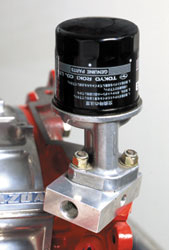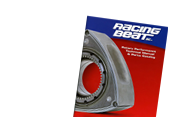Oil Cooling Tips

The TYPE I oil pressure and temperature adapter block allows for the easy installation of aftermarket gauges in your RX-7.
The stock engine oiling systems found on both the non-turbo and turbo rotary engines are exceptionally good and entirely adequate for even mildly modified engines.
Oil Pressure
Oil pressure in a stock engine ranges from 20 to 40 psi at idle RPM. Above 3,000 RPM oil pressure is approximately 70 PSI max (Except: 1993-95 RX-7 - 110 PSI max, 2004-08 RX-8 - 80 PSI Max, 2009-2011 - 115 PSI max), but may drop about 10 PSI above 4,000 RPM due to oil foaming. Oil foaming results when oil, as it is cooling the rotors, thrashes inside the rotors and traps air.
As a general rule, oil pressure should be increased as the horsepower output and engine RPM increase. As horsepower and RPM demands increase, it is beneficial to have higher oil pressure between the shafts and bearings to prevent possible catastrophic contact between spinning components. Additionally, as oil pressure is increased, flow rate also increases; hence, more oil is available to cool the bearings and rotors.
To obtain higher oil pressure from a 1995 and earlier engine equipped with a conventional oil pump (as opposed to a "dry sump" pump), several actions are desirable. First, leave out the front cover gasket, and use only the RX-7 front cover-to-front housing O-ring (Mazda P/N N231-10-174), which is thicker than previous models. Be sure to use "silicone seal" in place of the gaskets on the sealing surfaces of the front cover. This process reduces the chance of leakage from the oil passage between the front cover and front housing. Next, select an oil pump size suitable for the job.
For street high-performance use in 1979 and earlier engines, 80 to 85 psi can be obtained by shimming the stock rear oil pressure regulator 1/8". For 1980-92 12A and 13B engines (NT/Turbo), the regulator cannot be disassembled, so the best choice is the Racing Beat Street High-Performance Rear Oil Pressure Regulator. Beyond this pressure level, use the Racing Beat Race Rear Oil Pressure Regulator, which is set at approximately 105 to 115 psi. Due to the higher pressure provided by this regulator, using the race regulator for street use will accelerate wear on the oil pump. For 2004-08 RX-8 Renesis applications we offer our Racing Beat Street Port Rear Oil Pressure Regulator which increases the pressure from 80 PSI max to 95 PSI max. The 2009-2011 RX-8 Renesis engine is not equipped with a rear oil pressure regulator from the factory and has a maximum nominal oil pressure of 115 PSI. We do not offer a method to increase oil pressure on this application.
Beginning in 1979, Mazda discontinued the oil pump chain tensioner. Although the tensioner does no harm, it apparently does no particular good, so it can be left off for simplicity if desired.
Oil Temperature
Oil temperature is critical in rotary engines. Oil temperature entering the engine should never be allowed to exceed 205°F. While many factors affect oil temperature, oil cooler size and location are very important to consider. Roughly one-third of all engine heat rejected via the water and oil cooling systems goes out through the oil cooler. The oil cooler should get about one-third of the total cooling air flow.
Another factor that inhibits heat transfer from oil is air bubbles that become trapped in the oil. Air acts as an insulator and reduces heat transfer. While rotaries have little tendency to foam the oil through windage in the oil pan, as do reciprocating engines, air is mixed with the oil as the oil moves through the rotors. By slowing the oil as it returns to the pan, air is allowed additional time to separate from the oil. Our Oil Baffle Plate is designed to perform this function.
Oil Viscosity
When selecting engine oil viscosity, we offer these considerations. First, if your vehicle is stock or near stock, follow Mazda's recommendations. For street or light racing use (autocross or occasional drag racing) with a substantially modified engine, it may be wise to move up to a 10W30 oil. For normally aspirated racing, 10W40 is appropriate, and for turbo racing, you may need 20W50 to maintain oil pressure at high oil temperatures. Just a word of caution : The higher the viscosity, the slower the oil circulates through the engine. This is particularly of concern in rotaries, where the rotors are cooled internally by oil sprayed from 2 jets in the eccentric shaft. If you choose too high a viscosity, you will actually decrease cooling flow to the rotors.
Copyright 2007-2024 Racing Beat, Inc ©




